HP Stream 7 Review: A $119 Windows Tablet
by Brandon Chester on December 19, 2014 8:00 AM ESTDisplay
The display is one of the most important aspects of a device, as it's the portal for interaction between the user and the software. Unfortunately, with inexpensive devices like the Stream 7, the display is often the first thing to be put on the chopping block. It's simply very difficult to put a high quality panel in a low cost device and make money selling it. That being said, HP has actually attempted to put a decent panel in the Stream 7 considering its price target.
Like I stated before, many other tablets at this size and price point either opt for a TN panel, or they reduce the resolution to 1024x600 or even go lower to 800x480, which is borderline unusable. HP has put a 1280x800 IPS panel in the Stream 7, which is fairly good considering that two years ago most Android tablets of any size shipped with that same resolution. The glass is highly reflective, and this is coupled with the fact that the display isn't laminated. There's also some light bleed at the bottom, but at $119 I can excuse this.
Of course, specs that you read on paper like size and resolution only tell part of the story. Color accuracy, brightness, and contrast all have an impact on overall display quality, and to measure these we use SpectraCal's CalMAN 5 software along with X-Rite's i1Pro 2 spectrophotometer and i1Display Pro colorimeter.
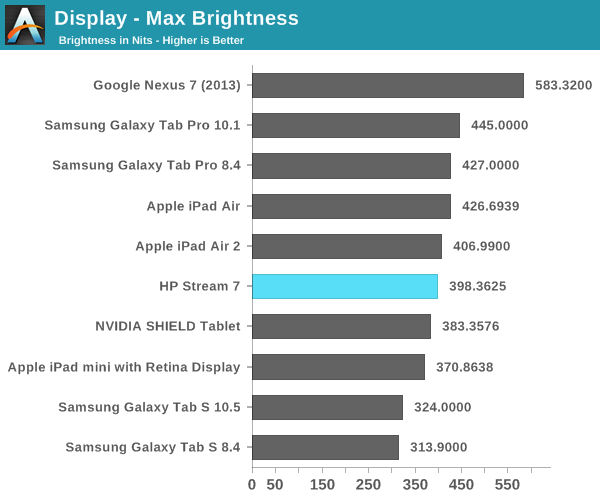
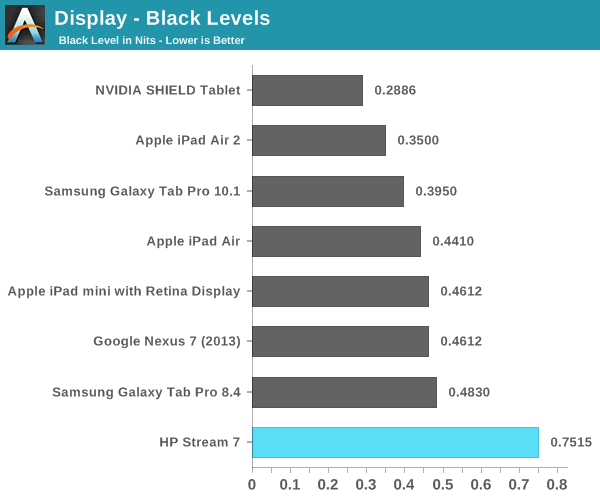
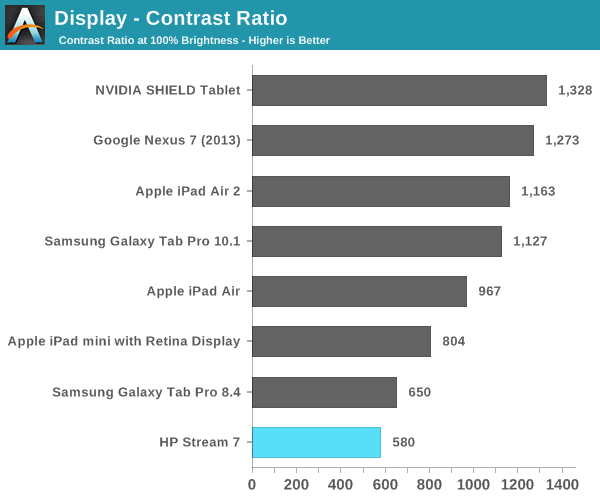
As you can see, the brightness of the Stream 7 is competitive with other tablets. Unfortunately, the black levels are just too high, which in turn leads to a very low contrast ratio. It should be noted that these measurements were achieved by disabling Intel's Display Power Saving Technology (DPST) feature, which causes dynamic brightness and contrast depending on the image displayed on the screen. While some other devices do this to some degree, DPST ended up reducing max brightness measurements by nearly 100nits, and the constantly changing brightness played havoc with measurements during analysis and calibration.


In the grayscale we see a shift toward blue, with the red steadily dropping off as brightness increases. This leads to the grayscale performance being some of the worst we have tested, but at $119 there's really no room for HP to do any calibration to the display panels at the factory.
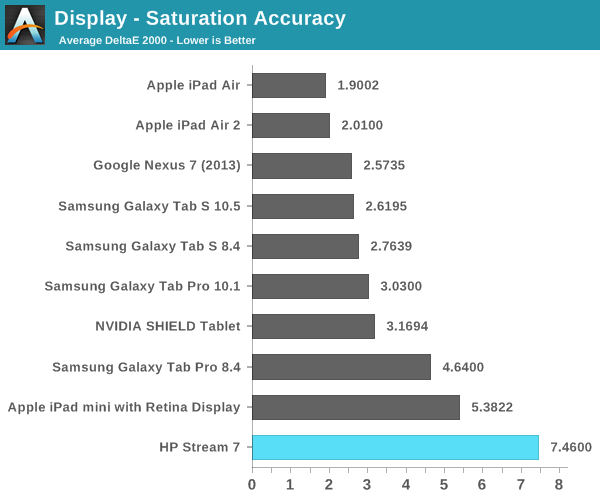
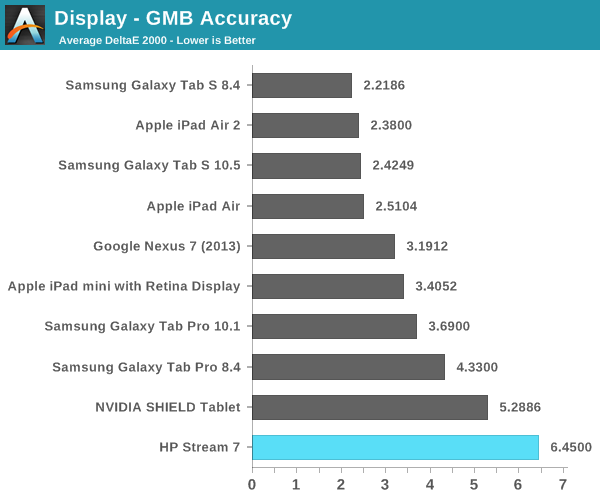
As with the grayscale test, we see poor performance in the saturation sweep. The display does not cover all of sRGB, and we see that for each 20% increment in the saturation sweep, the red, blue, and magenta saturations are all 20% lower than they should be and just generally inaccurate. The poor grayscale and saturation performance leads to a high average error in the color checker test, which means that the Stream 7 is not going to be able to accurately reproduce colors.
Again, this is to be expected with a device of this price point. It does however provide a good example of how the idea that IPS technology correlates with color accuracy is a misconception. With the prices of IPS displays being driven into TN territory by affordable eIPS panels, having an IPS display really just guarantees better viewing angles than a TN panel, nothing more.
One last thing to note about the display which does not show up in any measurements is that it is a 6bit + AFRC eIPS panel. This is not uncommon even in desktop monitors that cost as much as $400, but it does mean that there is noticeable posterization compared to a display with actual 8-bit color depth for red, green, and blue. This is not helped by the fact that Internet Explorer is not smart about displaying images; it doesn't seem to apply the same dithering that Chrome and Firefox do to mask color banding.
Calibration
Fortunately, the HP Stream 7 runs Windows. Unlike Android and iOS, Windows has color management capabilities. This allows us to calibrate the Stream 7 in an attempt to fix some of the issues with the display. We are working with a narrow gamut panel here so we aren't going to see much improvement to the saturation test, but we can certainly improve grayscale and color accuracy within the display's gamut.
After creating and applying an ICC profile created by CalMAN, we see a dramatic improvement in grayscale performance on the Stream 7. Gone is the shift toward blue, with a white point of 6595K that is very close to standard. Shades of grey are now accurate enough that you would be unable to see a difference from a reference monitor. These improvements unfortunately are accompanied by a significant drop in luminance, with a max display brightness of 308.5 nits after calibration.
We see slight improvement in the saturation sweep, but it's still nothing exceptional and unfortunately bound by the display's small color gamut. However, there's a significant improvement in the color checker test, although much of this can be attributed to the improvements in grayscale. There is an overall improvement in the accuracy of colors, but a few colors actually have a greater error after calibration than before. The biggest improvements are to mixtures of green and red, which has a significant impact on photos and videos by improving the accuracy of skin tones.
Overall, I'm surprised that the Stream 7 was able to be improved this much. It's certainly not perfect after calibration but it's much better. Unfortunately, I don't think many buyers of the Stream 7 are going to have the necessary equipment to calibrate the display properly, so it's more of an academic exercise.


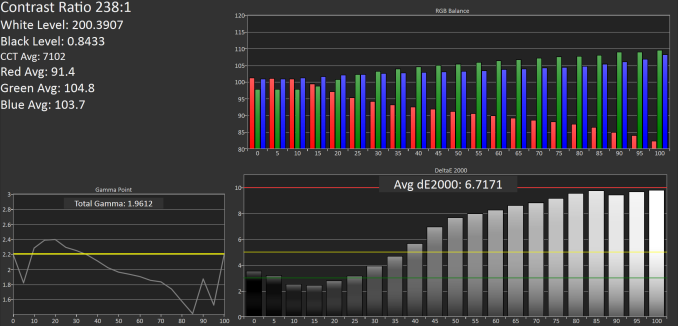
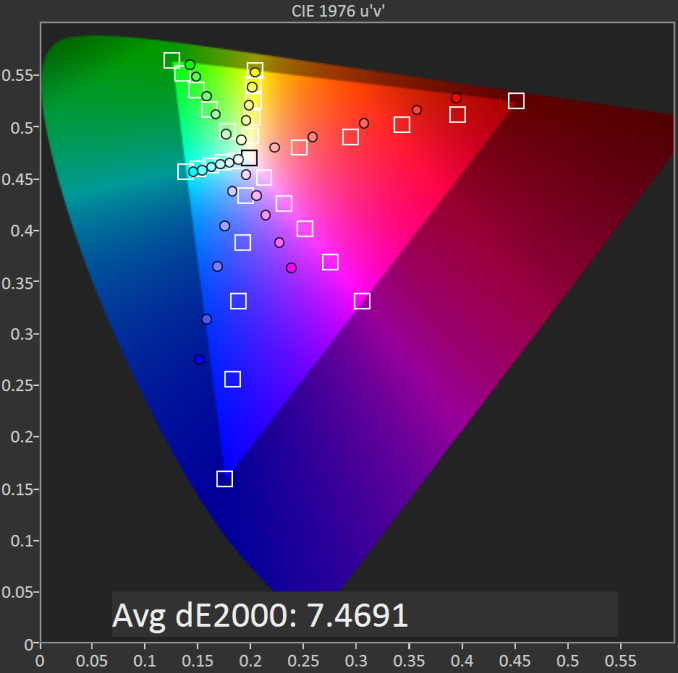
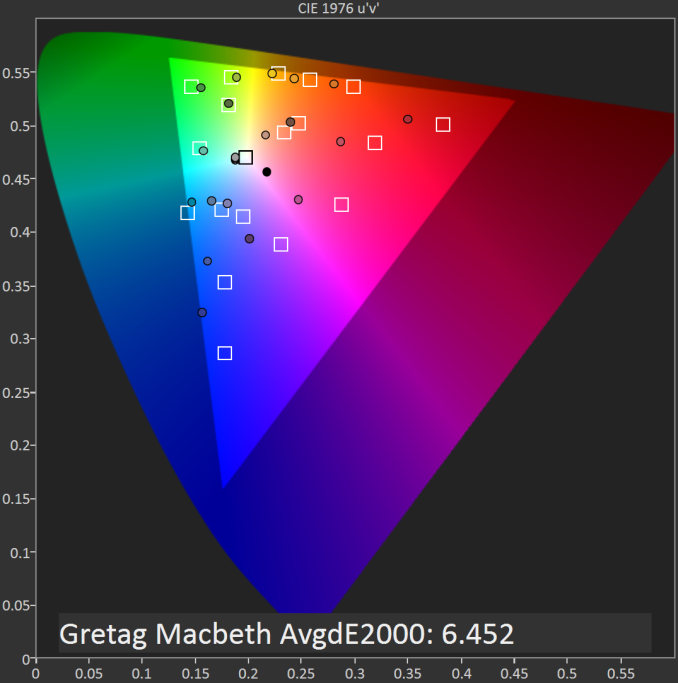
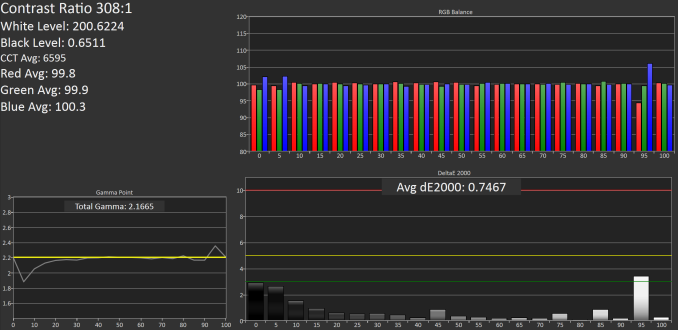
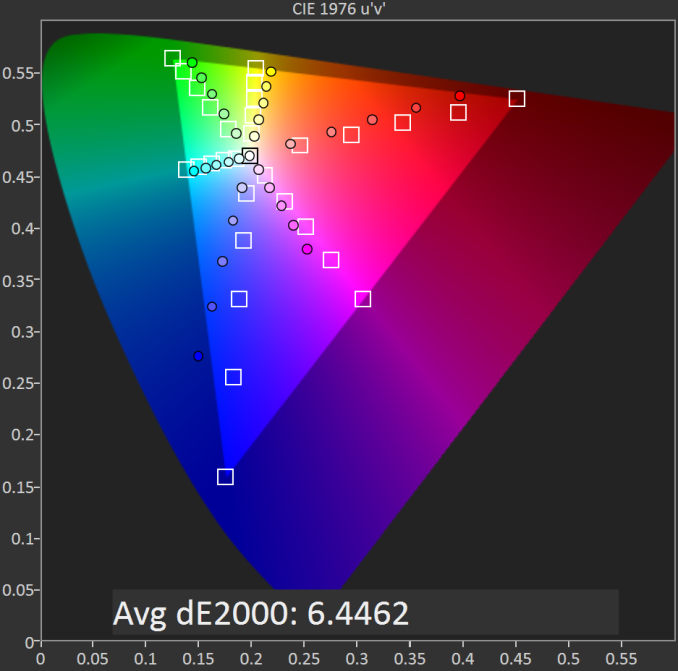
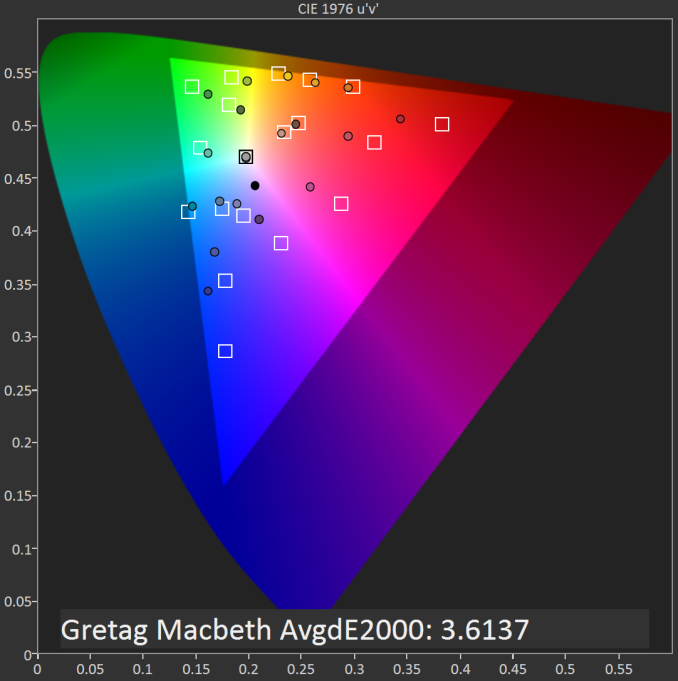








157 Comments
View All Comments
lazymangaka - Sunday, December 21, 2014 - link
I wonder if the headphone static is a problem with the Bay Trail chips or something weird with this zero cost version of Windows, because my Acer Iconia W4-820 also suffers from an annoyingly large amount of static over its 3.5mm headphone jack.Regular Reader - Monday, December 22, 2014 - link
Interesting. I have an Iconia W4 and haven't noticed the static. Does it happen to you at any volume level?AllanMoore - Monday, December 22, 2014 - link
If you live close to a MicroCenter, a much better pick would be the Winbook TW800 ($ 100). It's got a full USB 3.0, hdmi, micro sd, ips. In my opinion, it's by far the best $ 100 out there. Otherwise i would add extra $49 and buy <a href="http://www.amazon.com/gp/product/B009X3UW2G?ie=UTF... Asus Nexus 7</a>. It's faster and better value!ados_cz - Monday, December 22, 2014 - link
Whether it is a better value depends on user, I prefer the full windows 8.1 on my Linx 7, bookmark bar in IE synchronizes with my desktop pc as well as bunch of other things. It is just nice to have a proper PC in pocketable form factor. I have even found a very nice touch screen touchpad in windows store for mouse cursor navigation, handy when you connect external screen and extend the desktop. I just really love this cheap windows tablet. Linx 7 is sooo nice, 280g of full PC experience goodness :-) I have even sold my very good touchscreen Dell e5440 because it became obsolete to me, still keeping hi end mini itx desktop.harrynsally - Monday, December 22, 2014 - link
With HDMI and full size USB, I thought of getting one of these to use with external monitor and wireless keyboard/mouse.At $100, the TW800 WinBook only has 1GB RAM and 16GB eMCC storage. Even after tuning, Win 8.1 will use 95% of the storage and adding microSD only good for saving photos, documents.
For $200, you can get the TW100 WinBook that comes with 2GB RAM and 32GB eMCC storage, which will allow room to run additional software.
Did my homework and just purchased a Dell Inspiration NoteBook for $300. that included a Haswell i3 processor, 15.6" touch screen, 4GB RAM, 500GB storage, HDMI, 3 USB ports including one 3.0), optical DVD drive, 4 cell battery etc.
marvdmartian - Monday, December 22, 2014 - link
Bought one of these on BF, on sale from Office Depot for $79. Tried it for a few weeks, and I'm shipping it back to them today.Frankly, I was underwhelmed with it. As pointed out in the review, battery life is dismal.....even when it's on standby! While I wasn't using it every day, I did try to pick it up whenever possible, to attempt to immerse myself in the Windows 8 experience, as this was my first W8 device. But it seemed as though every time I picked it up to use it, I had to plug it in and charge it first! Sorry, but sitting there, doing NOTHING for 3 days, and the battery dies (from WHAT??) is NOT acceptable to me.
As I already said, this was my first W8 device.....and will likely be my last one, too. I know, I know, some people are enamored with it, and think it's the greatest thing since sliced bread. But I'm just not impressed with it (and this is the improved Windows 8?? yikes!). I have used pretty much every version of Windows since 95, and found this one to be the least intuitive one of all. Hopefully Windows 10 will bring back some of the simplicity of the older versions!
As I said, this is being shipped back today. I did a refresh of the operating system (to wipe my info off of it), boxed it up, and Office Depot is paying the return shipping. In its place, I'm looking at the year old Asus 7" tablets, running Android. I've owned one of the newer 10" tablets made by them for almost a year now, and have been much more impressed with their products, as well as their value, than any other manufacturer out there.
kg4icg - Monday, December 22, 2014 - link
I actually have this tablet, been using it for a couple of weeks now. Not bad at all,, Have a 64gb Samsung SXDC UHS-1 card in it. Actually use it to program radios in the field by way of USB-OTG adapter. Use my phone as a hotspot whenever I need to do something online. Not bad for something I picked up from Microsoft for $100. Oh by the way, I'm posting this comment thru it.kg4icg - Monday, December 22, 2014 - link
By the way, only the Back cover is plastic, the frame is metal, possibly aluminum. A Plastic tablet this size is half the weight, Namely the Samsung Tab 4.BuddyRich - Monday, December 22, 2014 - link
I recently bought a DVP8 on-sale (wanted more RAM) but considered the Stream 7.I justified it as a Raspberry Pi with a built-in screen. I mean outfitted with a case you are spending $35 to 45 for that Pi Whats another $50-60 for a multi-touch screen if you have a use for it? If you don't, obviously don't spend on it. I bought it to be a replacement for a squeezebox touch, which this does superbly.
It comes with a Windows License which is handy, you can still get Linux on it if you want the lighter-weight OS... I think the UX is rough using desktop Windows with touch. They really should have put the keyboard on the charms bar rather than taskbar as you'll be using it alot if you don't use a bluetooth keyboard.
My only complaint is the OS is not a "pro" license so I had to use Team Viewer rather RDP to connect to my device.
Wolfpup - Tuesday, December 23, 2014 - link
So glad you guys reviewed this! Very disappointing that the headphone jack is bad. Everything else seems...well, not bad or even good for a $100 tablet, but not being able to use this for media, when otherwise it would be AWESOME for media since it's real Windows kind of kills it for me.Meanwhile I think it was Toshiba has a cheap 7" one too but it's killed by using a 1024x800 (?) screen with a higher resolution scaled down to it. Seems like it both cases spending the extra $60 or whatever for the 8" tablets would be the way to go (assuming the 8" models don't have these problems).
Worth noting that actually the Windows desktop is VERY useable on a 10.6" screen...it even works pretty well through my iPad's 9.7" screen with remote desktop. (The issues there are more just that there's a bit of lag/weirdness since it's sending touch commands across a wifi network!)